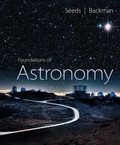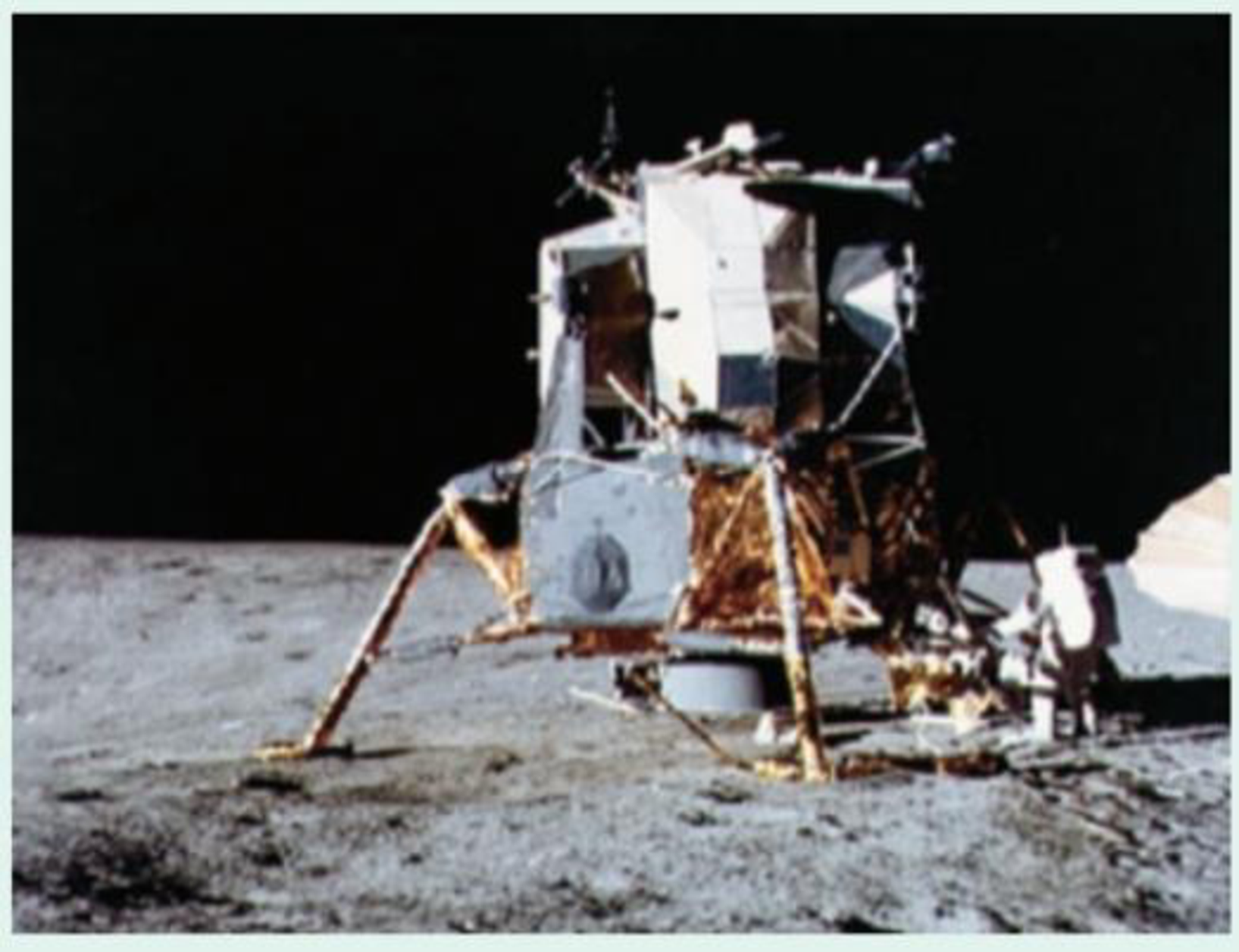
EBK FOUNDATIONS OF ASTRONOMY
14th Edition
ISBN: 8220106820612
Author: Backman
Publisher: YUZU
expand_more
expand_more
format_list_bulleted
Textbook Question
Chapter 20, Problem 2LTL
In the photo shown here, astronaut Alan Bean works at the Apollo 12 lander. Describe the horizon and the surface you see. What kind of terrain did they land on for this, the second human Moon landing, and why?

Expert Solution & Answer
Trending nowThis is a popular solution!

Students have asked these similar questions
Why Wait? To explore a planet, we often send first a flyby, then an orbiter, then a probe or a lander. There’s no doubt that probes and landers give the most close-up detail, so why don’t we send this type of mission first? For the planet of your choice, based just on the information in this chap- ter, give an example of why such a strategy might cause a mission to provide incomplete information about the planet or to fail outright.
Planetary scientists are hoping that the samples collected by the Perseverance Mars rover will eventually be collected by other robotic spacecraft and returned to Earth. Even if Perseverance could collect samples from all over Mars's surface, why wouldn't this tell us what the entire planet is made of?
Group of answer choices
The deep interior of Mars has had its composition altered (compared to the surface) by the impacts of asteroids that plunged almost all the way down to Mars's center.
Since Mars has a powerful magnetic field, it must have a liquid-iron portion of its core, and this material can't be collected by a rover on the surface.
Early in its history, Mars differentiated into layers of materials that had different densities, much like the Earth did.
Mars has such a low density that most of its interior must be made of liquid water and ice, so rocks from the surface simply won't be representative of the deep interior.
Which of the following planetary traits is well established?
choose one of the following:
a) Mercury has a similar compositon to that of our moon, in that they both have a substantial metal content.
b) Venus rotates more rapidly than Earth, but in the opposite direction.
c) Earth's atmosphere exhibits a slightly stronger greenhouse effect than that seen on Venus.
d)Astronomers have precisely calculated the mass of Mercury thanks to artificial satellites sent from Earth.
Chapter 20 Solutions
EBK FOUNDATIONS OF ASTRONOMY
Ch. 20 - How does the force of gravity cause tidal coupling...Ch. 20 - As viewed from Earth, how many times does the Moon...Ch. 20 - If the Moon is tidally coupled to Earth, is Earth...Ch. 20 - How can you determine the relative ages of the...Ch. 20 - From looking at images of the Moons near side, how...Ch. 20 - Why did the first Apollo missions land on the...Ch. 20 - Why do planetary scientists hypothesize that the...Ch. 20 - Prob. 8RQCh. 20 - Prob. 9RQCh. 20 - Prob. 10RQ
Ch. 20 - What is the most significant kind of erosion that...Ch. 20 - Provide evidence to support a hypothesis about...Ch. 20 - What evidence can you cite that the Moon had...Ch. 20 - What evidence would you expect to find on the Moon...Ch. 20 - How does the large-impact hypothesis explain the...Ch. 20 - Look at the Celestial Profiles for Earth, the...Ch. 20 - Look at the Celestial Profiles for the Moon and...Ch. 20 - Prob. 18RQCh. 20 - Look at the Celestial Profiles for Earth, the...Ch. 20 - Look at the Celestial Profiles for the Moon and...Ch. 20 - Why are features like the Moons maria not observed...Ch. 20 - What are the relative ages of the intercrater...Ch. 20 - What evidence can you give that Mercury has a...Ch. 20 - Why is it not surprising that there is no evidence...Ch. 20 - What evidence can you give that Mercury had...Ch. 20 - How are the histories of the Moon and Mercury...Ch. 20 - What property of the Moon and Mercury has resulted...Ch. 20 - Prob. 28RQCh. 20 - Look at the right top and bottom images in Figure...Ch. 20 - Calculate the escape velocity of the Moon from its...Ch. 20 - Prob. 3PCh. 20 - Why do small planets cool faster than large...Ch. 20 - The smallest detail visible through Earth-based...Ch. 20 - Prob. 6PCh. 20 - The trenches where Earths seafloor slips downward...Ch. 20 - An Apollo command module orbited the Moon about...Ch. 20 - Prob. 9PCh. 20 - What is the angular diameter of Mercury when it is...Ch. 20 - If you transmit radio signals to Mercury when...Ch. 20 - What is the wavelength of the most intense...Ch. 20 - Suppose you send a probe to land on Mercury, and...Ch. 20 - The smallest detail visible through Earth-based...Ch. 20 - Prob. 1SOPCh. 20 - Prob. 2SOPCh. 20 - Look at the image of the astronaut on the Moon at...Ch. 20 - In the photo shown here, astronaut Alan Bean works...Ch. 20 - Examine the shape of the horizon at the Apollo 17...
Knowledge Booster
Learn more about
Need a deep-dive on the concept behind this application? Look no further. Learn more about this topic, physics and related others by exploring similar questions and additional content below.Similar questions
- We believe that all of the terrestrial planets had similar histories when it comes to impacts from space. Explain how this idea can be used to date the formation of the martian highlands, the martian basins, and the Tharsis volcanoes. How certain are the ages derived for these features (in other words, how do we check the ages we derive from this method)?arrow_forwardOne source of information about Mars has been the analysis of meteorites from Mars. Since no samples from Mars have ever been returned to Earth from any of the missions we sent there, how do we know these meteorites are from Mars? What information have they revealed about Mars?arrow_forwardWhy isnt the crust of Mars broken into mobile plates as Earths crust is? How do you know?arrow_forward
- Describe sources and sinks of CO2, if any, on Mars today.arrow_forwardWhat evidence do we have that there was running (liquid) water on Mars in the past? What evidence is there for water coming out of the ground even today?arrow_forwardThe runaway greenhouse effect and its inverse, the runaway refrigerator effect, have led to harsh, uninhabitable conditions on Venus and Mars. Does the greenhouse effect always cause climate changes leading to loss of water and life? Give a reason for your answer.arrow_forward
- Olympus Mons on Mars is an enormous volcano. In this image, you can see multiple calderas (craters) at the top. What do the numbers of calderas and the immense size of the volcano indicate about the geology of Mars?arrow_forwardWhy do small planets cool faster than large planets? Choose any two of the five Terrestrial worlds and calculate for each one the ratio of its surface area to its volume. Why is this ratio important? (Hint: Does this ratio have anything to do with the ability of a planet to lose internal heat?) (Note: The surface area of a sphere is 4r2, and the volume of a sphere is 43r3.)arrow_forwardHow does beltzone circulation transport energyby radiation, conduction, or convection? Explain your answer.arrow_forward
- Look at the map of the Hawaiian chain of islands on the right-hand page of the Concept Art: Volcanoes. Which island formed most recently? How do you know? Is the newly formed volcano of a type found on Venus, on Mars, on both planets, or on neither?arrow_forwardWhat surface features on Mars today indicate that there was significant water erosion in the past?arrow_forwardDo either Venus or Mars have composite volcanoes? Why or why not?arrow_forward
arrow_back_ios
SEE MORE QUESTIONS
arrow_forward_ios
Recommended textbooks for you
 Foundations of Astronomy (MindTap Course List)PhysicsISBN:9781337399920Author:Michael A. Seeds, Dana BackmanPublisher:Cengage Learning
Foundations of Astronomy (MindTap Course List)PhysicsISBN:9781337399920Author:Michael A. Seeds, Dana BackmanPublisher:Cengage Learning

 AstronomyPhysicsISBN:9781938168284Author:Andrew Fraknoi; David Morrison; Sidney C. WolffPublisher:OpenStax
AstronomyPhysicsISBN:9781938168284Author:Andrew Fraknoi; David Morrison; Sidney C. WolffPublisher:OpenStax Horizons: Exploring the Universe (MindTap Course ...PhysicsISBN:9781305960961Author:Michael A. Seeds, Dana BackmanPublisher:Cengage Learning
Horizons: Exploring the Universe (MindTap Course ...PhysicsISBN:9781305960961Author:Michael A. Seeds, Dana BackmanPublisher:Cengage Learning

Foundations of Astronomy (MindTap Course List)
Physics
ISBN:9781337399920
Author:Michael A. Seeds, Dana Backman
Publisher:Cengage Learning



Astronomy
Physics
ISBN:9781938168284
Author:Andrew Fraknoi; David Morrison; Sidney C. Wolff
Publisher:OpenStax

Horizons: Exploring the Universe (MindTap Course ...
Physics
ISBN:9781305960961
Author:Michael A. Seeds, Dana Backman
Publisher:Cengage Learning
Kepler's Three Laws Explained; Author: PhysicsHigh;https://www.youtube.com/watch?v=kyR6EO_RMKE;License: Standard YouTube License, CC-BY